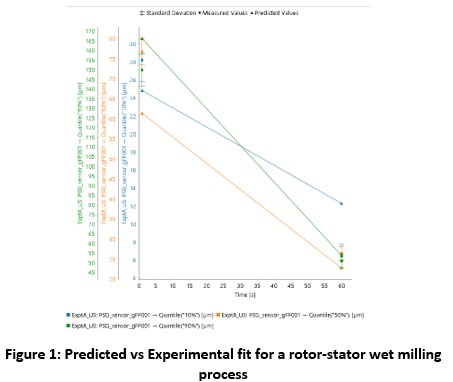2022 Annual Meeting
(138d) Wet Milling of Mefenamic Acid for Seed Generation: Model-Driven Size Reduction for Maximizing Yield
Authors
There is an increasing interest in the application of continuous processing technologies using continuous crystallization in pharmaceutical manufacturing to control crystal properties and deliver consistent particulate products (Bosetti & Mazzotti, 2020; Brown et al., 2018). Whilst widely used in the production of large volume commodity chemicals, there is increasing number of industrial examples and support from regulatory authorities including the FDA in demonstrating the potential value of continuous crystallization in the supply of medicines and other high value chemicals. Recent integration of wet media milling technologies, particularly rotor-stator devices, have been shown to avoid common issues encountered with traditional dry milling units. These include introduction of crystal lattice disorder, undesired polymorphic and amorphous transformations, reduced operator exposure to high potency APIs, broad bimodal particle size distributions, loss of yield and process control, as well as increased energy cost (Agimelen et al., 2018; Ahmed et al., 2019; Szilagyi & Nagy, 2019).
The aim of this work is to explore the region of attainable particle sizes based on the performance of a wet milling model. In detail, this work focuses on the development of a mechanistic model to describe the wet milling process, with a view to parametrize the breakage kinetics, optimize the milling performance and explore the effects on downstream processes, such as crystallization.
Key Results:
Lab-scale experiments with varying rotor frequency were conducted with a rotor-stator wet mill to collect data that would allow for the estimation of breakage kinetics. Results from model validation showed that with the dataset used for modelling, the model was able to effectively estimate the crystallization and breakage performance, as shown in Figure 1 (attached).
A controlled and robust wet mill process used for seed generation would aid in continuous crystallization processes by allowing for better control in final crystal quality attributes like particle size distribution. The effect of seed sizes on a continuous crystallization process can therefore allow for a wider study of the design space and a better understanding of the optimal process conditions.
References:
- Agimelen, O., Svoboda, V., Ahmed, B., Cardona, J., Dziewierz, J., Brown, C., . . . Sefcik, J. (2018). Multi-sensor inline measurements of crystal size and shape distributions during high shear wet milling of crystal slurries. Advanced Powder Technology, 29(12), 2987-2995. doi:10.1016/j.apt.2018.09.003
- Ahmed, B., Brown, C., McGlone, T., Bowering, D., Sefcik, J., & Florence, A. (2019). Engineering of acetaminophen particle attributes using a wet milling crystallisation platform. International Journal of Pharmaceutics, 554, 201-211. doi:10.1016/j.ijpharm.2018.10.073
- Bosetti, L., & Mazzotti, M. (2020). Population Balance Modeling of Growth and Secondary Nucleation by Attrition and Ripening. Crystal Growth & Design, 20(1), 307-319. doi:10.1021/acs.cgd.9b01240
- Brown, C. J., McGlone, T., Yerdelen, S., Srirambhatla, V., Mabbott, F., Gurung, R., . . . Florence, A. J. Y. (2018). Enabling precision manufacturing of active pharmaceutical ingredients: workflow for seeded cooling continuous crystallisations. Molecular Systems Design & Engineering(3), 518. doi:10.1039/c7me00096k m3 - 10.1039/c7me00096k
- Szilagyi, B., & Nagy, Z. (2019). Model-based analysis and quality-by-design framework for high aspect ratio crystals in crystallizer-wet mill systems using GPU acceleration enabled optimization. Computers & Chemical Engineering, 126, 421-433. doi:10.1016/j.compchemeng.2019.04.025

